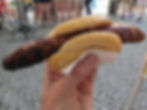The Best of the "Wurst"
- Scott
- Jul 31, 2014
- 3 min read
Germany is infamous for its many varieties of Wursts (pronounced 'versts'). Here in America, we call them sausages. As I learned on my voyage through Germany, many cities or regions have their own unique Wurst, and I made it my goal to try as many different Wursts as possible. By the way, I am capitalizing Wurst because most nouns in German are capitalized, no matter where they occur in the sentence.
First up, we have Currywurst in Berlin. It is a steamed, then fried pork sausage, similar to a hotdog but thicker, cut into slices and seasoned with curry powder and ketchup. I enjoyed my Currywurst with Pommes Frites (French Fries) and Orange Fanta at a great little stand, Curry Uw (curryuwe.de), next to Olivaer Platz park in Berlin. I will be honest. I really enjoyed the combined taste of the curry and ketchup on the sausage. The curry gave it a little spice and the ketchup sweetened it.

Currywurst

Curry Uw stand in Berlin
Thüringer Rostbratwurst is a spicy sausage from the region of Thuringia that is usually about 15–20 cm (6 to 8 inches) long and thin in shape, traditionally grilled over a charcoal fire, so that some charring occurs. It is served in a short bun, so that the ends sick out. The Thüringer Rostbratwurst is truly a fast food sausage, almost always sold at a Bratwurst Imbiss (fast food stand). I sat on the stoop of a nearby building to eat my Wurst, since there was no seating nearby!

Thüringer Rostbratwurst

Thüringer Rostbratwurst stand in Weimar
Blaue Zipfel, which is a Franconian dish of Bratwurst boiled in vinegar and onions. Mine was served in the onion and vinegar brew with a salad of carrots, arugula, radishes, and tomatoes, along with a slice of dark brown German bread. In the picture, the coloring is off because I was sitting under a red umbrella at the Restaurant Cafe Zeis.

Blaue Zipfel

Restaurant Café Zeis in Bamberg
Nürnberger Rostbratwurst, which are the smallest and thinest of the German Wursts at only 7 to 9 cm (2.5 to 3.5 inches) in length. They are pork-based, usually seasoned with fresh marjoram, and traditionally grilled over a beechwood fire. As a main dish, they are traditionally served in a set of six on a pewter plate with sauerkraut and potato salad. I also enjoyed mine with mustard. We ate at the Bratwurst Röslein (www.bratwurst-roeslein.de).

Nürnberger Rostbratwurst

Bratwurst Röslein in Nürnberg
Weisswurst was the Wurst of choice in Munich! It is a traditional Bavarian sausage made from very finely minced veal and fresh pork back bacon. It is usually flavoured with parsley, lemon, mace, onions, ginger, and cardamom. As a Munich tradition, it is served with a pretzel and sweet mustard. To wash it all down, a Weißbier is the usual beverage of choice. As you can see in the photo, I had issues in pouring my beer. I enjoyed my Weisswurst at the Viktualienmarkt in Munich. The only catch was that it was so crowded (we arrived at noon), I had to eat my meal while sitting on a bench next to a tree - no table for me!

Weisswurst

Viktualienmarkt in Munich
Bratwurst, which I had at the Alpenstuben Biergarten Grill near Neuschwanstein Castle. From what I could tell, it was a typical traditional pork bratwurst, which I had with mustard.

Bratwurst
So, I enjoyed six different Wursts in ten days in Germany. Which was the "Best of the Wursts?" To be honest, I enjoyed all of them!



